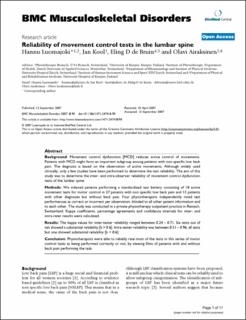Please use this identifier to cite or link to this item:
https://doi.org/10.21256/zhaw-1940| Publication type: | Article in scientific journal |
| Type of review: | Peer review (publication) |
| Title: | Reliability of movement control tests in the lumbar spine |
| Authors: | Luomajoki, Hannu Kool, Jan De Bruin, Eling D. Airaksinen, Olavi |
| DOI: | 10.21256/zhaw-1940 10.1186/1471-2474-8-90 |
| Published in: | BMC Musculoskeletal Disorders |
| Volume(Issue): | 8 |
| Issue: | 90 |
| Issue Date: | 2007 |
| Publisher / Ed. Institution: | BioMed Central |
| ISSN: | 1471-2474 |
| Language: | English |
| Subjects: | Pelvic tilt; Rater pair; Intrarater reliability; Relative flexibility; Substantial reliability |
| Subject (DDC): | 615.82: Physical therapy 617.5: Orthopaedic surgery |
| Abstract: | Background: Movement control dysfunction [MCD] reduces active control of movements. Patients with MCD might form an important subgroup among patients with non specific low back pain. The diagnosis is based on the observation of active movements. Although widely used clinically, only a few studies have been performed to determine the test reliability. The aim of this study was to determine the inter- and intra-observer reliability of movement control dysfunction tests of the lumbar spine. Methods: We videoed patients performing a standardized test battery consisting of 10 active movement tests for motor control in 27 patients with non specific low back pain and 13 patients with other diagnoses but without back pain. Four physiotherapists independently rated test performances as correct or incorrect per observation, blinded to all other patient information and to each other. The study was conducted in a private physiotherapy outpatient practice in Reinach, Switzerland. Kappa coefficients, percentage agreements and confidence intervals for inter- and intra-rater results were calculated. Results: The kappa values for inter-tester reliability ranged between 0.24-0.71. Six tests out of ten showed a substantial reliability [k > 0.6]. Intra-tester reliability was between 0.51-0.96, all tests but one showed substantial reliability [k > 0.6]. Conclusion: Physiotherapists were able to reliably rate most of the tests in this series of motor control tasks as being performed correctly or not, by viewing films of patients with and without back pain performing the task. |
| URI: | https://digitalcollection.zhaw.ch/handle/11475/4953 |
| Fulltext version: | Published version |
| License (according to publishing contract): | CC BY 2.0: Attribution 2.0 Generic |
| Departement: | School of Health Sciences |
| Appears in collections: | Publikationen Gesundheit |
Files in This Item:
| File | Description | Size | Format | |
|---|---|---|---|---|
| 2007_Luomajoki_Reliability of movement_BMC Musculoskeletal Disorders.pdf | 2.7 MB | Adobe PDF |  View/Open |
Show full item record
Luomajoki, H., Kool, J., De Bruin, E. D., & Airaksinen, O. (2007). Reliability of movement control tests in the lumbar spine. BMC Musculoskeletal Disorders, 8(90). https://doi.org/10.21256/zhaw-1940
Luomajoki, H. et al. (2007) ‘Reliability of movement control tests in the lumbar spine’, BMC Musculoskeletal Disorders, 8(90). Available at: https://doi.org/10.21256/zhaw-1940.
H. Luomajoki, J. Kool, E. D. De Bruin, and O. Airaksinen, “Reliability of movement control tests in the lumbar spine,” BMC Musculoskeletal Disorders, vol. 8, no. 90, 2007, doi: 10.21256/zhaw-1940.
LUOMAJOKI, Hannu, Jan KOOL, Eling D. DE BRUIN und Olavi AIRAKSINEN, 2007. Reliability of movement control tests in the lumbar spine. BMC Musculoskeletal Disorders. 2007. Bd. 8, Nr. 90. DOI 10.21256/zhaw-1940
Luomajoki, Hannu, Jan Kool, Eling D. De Bruin, and Olavi Airaksinen. 2007. “Reliability of Movement Control Tests in the Lumbar Spine.” BMC Musculoskeletal Disorders 8 (90). https://doi.org/10.21256/zhaw-1940.
Luomajoki, Hannu, et al. “Reliability of Movement Control Tests in the Lumbar Spine.” BMC Musculoskeletal Disorders, vol. 8, no. 90, 2007, https://doi.org/10.21256/zhaw-1940.
Items in DSpace are protected by copyright, with all rights reserved, unless otherwise indicated.